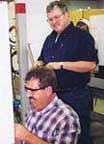
Is this a commercial refrigerator troubleshooting call for a unit that's totally dead?
If it's plugged into a wall outlet, you'll need to check the outlet for power, and it's always a good idea to verify that the ground and neutral are wired correctly. If it's wired to a disconnect, you'll need to check for power in the disconnect, and once again, it's always a good idea to verify that the ground and neutral are wired correctly.
If there's no power in the outlet or disconnect, you're going to have to find out why, and correct it. If there is power in the outlet or disconnect, check the plug, or the connections in the disconnect; then check the wiring and connections into the unit to see if there's a broken wire or loose connection.
A non-contact voltage detector is a quick way to find broken wires and open connections, on commercial refrigerator troubleshooting calls, or on any HVACR service call.
If there is an on/off switch on the unit, check it to see if it's working.
Be sure you have a good neutral. You might read a good voltage from your hot line to ground, but if your neutral line is bad, your unit won't run.
Is this a commercial refrigerator troubleshooting call for a unit that's freezing up?
Make sure the evaporator fan is running, and that it's rotating correctly. You may have to melt the ice off the evaporator first. Make sure the coil is clean, and that the drain line is clear.
If only the first section of evaporator piping is freezing up, you very likely have a low charge, or possibly a restricted drier, liquid line, or metering device.
Check your pressures, temperatures, superheat, and subcooling.
Our System Evaluation Manual at http://hvacr-resource.com/System_Evaluation_Manual.html has a cycle diagram and guidelines for evaluating pressures and temperatures for air conditioning and refrigeration systems.
Is this a commercial refrigerator troubleshooting call for a unit that might have a compressor problem?
Before you attach your gauges, is the compressor doing anything at all? Is it pulling any amperage? Is the compressor hot?
If it's making a sound like "mmmmmm-TINK.....mmmmmmmm-TINK", it's trying to start, but tripping off on its overload.
Disconnect the wiring from the compressor terminals and check the resistances of the windings. If there's an open winding, you'll have to replace the compressor. If the compressor is very hot, the internal overload may be open. It will take time for this to cool down and close, so don't condemn the compressor yet. You can either wait until it's cool, or cool it down with ice.
Once the overload closes, if the windings test OK, replace the start components and try to run the unit. If the compressor runs, the unit should cool OK if there are no other problems. If the compressor makes the "mmmmmm-TINK" noise again, it's locked up and must be replaced.
If the compressor is running, with very low amp draw, very high suction pressure, and very low discharge pressure, it has failed and must be replaced. Try to determine why it failed.
Is the condenser fan running? Is the condenser coil clean? Is hot air blowing into the condenser coil from another appliance?
If you're on a commercial refrigerator troubleshooting call and the compressor is running with low amp draw, low suction pressure, and low discharge pressure, you may have a low charge, or a restricted liquid line, drier, or metering device. Check the superheat and subcooling, and make the necessary repairs.
Is this a commercial refrigerator troubleshooting call for a unit that's cooling but not maintaining the correct refrigerator temperature?
Verify that the operating pressures, temperatures, superheat, and subcooling are in the normal range.
Make sure the gaskets are in good condition, are correct for the door, and are sealing well. If the temperature control is turned to its coldest setting, and it turns off the compressor at too warm a temperature, it has failed. Replace it.
On every commercial refrigerator troubleshooting call, check the fans; make sure they're running, turning in the right direction, and that the blades and motors are the right size.
Check the coils, and make sure they're clean.
Make sure no controls or safeties are bypassed.
Make sure the panels, grilles, and enclosures around the fans and coils are installed and providing good airflow.
Verify that the supply voltage, operating pressures, temperatures, superheat, and subcooling are in the normal range.
Publication date:01/08/2007







